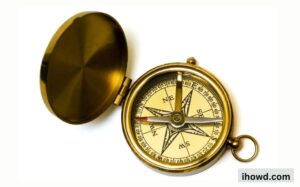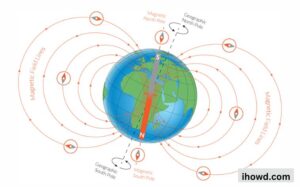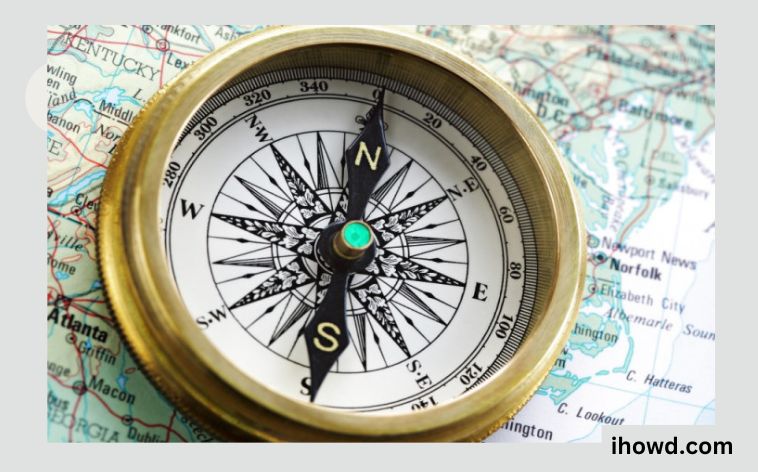Your best chance of locating yourself in the woods may be a little magnet.
The small magnetic pin of a compass is hung so that it can spin freely inside its housing and react to our planet’s magnetism. It is this motion that causes a compass to point north.
Explorers and wandering spirits are provided with a reliable sense of direction when a compass needle aligns and points upward in the Earth’s magnetic field.
Describe a compass

A magnetized metal needle positioned in such a way that it can freely spin makes up the most basic compass. (You may create one by magnetically coating a regular needle, inserting it gently on a piece of cork, and letting the cork float in a tray of water.) If the needle is left to turn on its own, it will point one end north and the other south. If you keep in mind that the Sun rises in the east and sets in the west, you can usually determine which end is which by looking at where it is in the sky. Therefore, if you’re gazing down at the floating needle at around noon and the Sun is somewhere in front of you, with the eye on the left and the point on the right, you’ll know the point is pointing north.
Related Who invented the Cell Phone?
How a Compass Operates
The inherent magnetic fields of the Earth are what a compass uses to navigate. Due to gravitational pressure, the iron core of the Earth is partially liquid and partially solid crystal. The Earth’s magnetic field is thought to be created by motion in the liquid outer core. The north and south poles are the two primary poles of the Earth’s magnetic field, which is true of all magnetic fields. These magnetic poles are a little bit off from the Earth’s axis of rotation, which serves as the foundation for the geographic poles, but they are close enough to allow for navigation using general directions and declination adjustments for the polar difference.
A compass is essentially a small magnet, usually a magnetised needle, mounted on a free-rotating pivot. This enables the needle to respond to adjacent magnetic fields more effectively. The southern pole of the needle is drawn to the north magnetic pole of the Earth because opposites attract. This is how navigators can tell which way is north. Chinese inventors during the Song era created the first compasses, which were water compasses. In a bowl of water, these were metal pieces that had been magnetised. The initial frictionless pivot required to create a functional compass is provided by the water.
Later, in the 14th century AD, the compass became widely used throughout the western world. Due to this, the world, including North and South America, was further explored by major European nations during what is now known as the Age of Exploration. Even while the compass was just one of the tools that helped create this era of discovery, it was a crucial factor. Even now, compasses and the more precise maps they helped create are still used in some ways for modern navigation.
Related How to Clean an LCD Screen?
Magnetic North versus True North

In September 2019, compasses at Greenwich pointed north for the first time in more than 360 years. Compasses don’t always accurately point in the direction of the North Pole, though.
The orientation that directly faces the geographical North Pole is known as true north. On the surface of the planet, this is a fixed point. A compass needle points in that direction when it is aligned with the Earth’s magnetic field, which is substantially different from true north.
The magnetic North Pole is not a fixed position; it shifts and changes throughout time in response to changes in the Earth’s magnetic core.
Declination is the name for the angle formed by true north and the north heading on a compass. The Earth’s magnetic field dips and undulates; it is not constant, which causes variations in declination from location to location.
The reasons compasses can be wrong
Compasses are incredibly helpful, yet they occasionally put us in danger due to two completely unrelated issues termed declination (or variation) and deviation. This is why.
Declination
The north pole, also known as the geographic north pole, which is located at the “top” of the globe, and the south pole serve as the axis around which Earth rotates (or geographic south pole, at the “bottom” of the planet). However, the magnetic field of Earth is a little off and doesn’t quite align with its axis of rotation. As a result, the magnetic north pole, which is where your compass points, is not exactly parallel to the real north pole, which is located several hundred kilometres (miles) away.
Related How to Recover your ICQ Password?
In actuality, there isn’t much of a distinction between “true north” and “magnetic north,” thus when using a compass and a map while travelling, you may typically treat the north that the compass indicates as if it were pointing toward the actual, geographic north pole. To be more precise, the declination or variation refers to the angle that fluctuates somewhat from place to place (and from year to year, since the location of Earth’s magnetic north is continually shifting) between “magnetic north” and “true north.” When really precise navigation is necessary (for instance, aboard ships), the declination must be taken into consideration and corrected for.
Deviation
Although a compass is made to respond to the magnetic field produced by the hot, spinning mass of rock thousands of kilometers/miles deep under the Earth, there are many other factors that might cause it to become seriously out of alignment. All that metal, whether it be in a car or an iron ship, for instance, can have a significant impact. The deviation is the angle between where the compass would point if it were absolutely accurate (magnetic north) and where it actually points. It measures the accuracy of a compass measurement in a specific situation.
Your compass needle will be impacted and its accuracy will decrease if there is a magnet nearby, a particularly magnetic portion of the Earth’s crust is close by, or if there are varying electric currents producing magnetic fields. The most advanced compasses feature compensating magnets or iron parts that you may adjust to neutralise any local magnetic effects incorporated into them.
